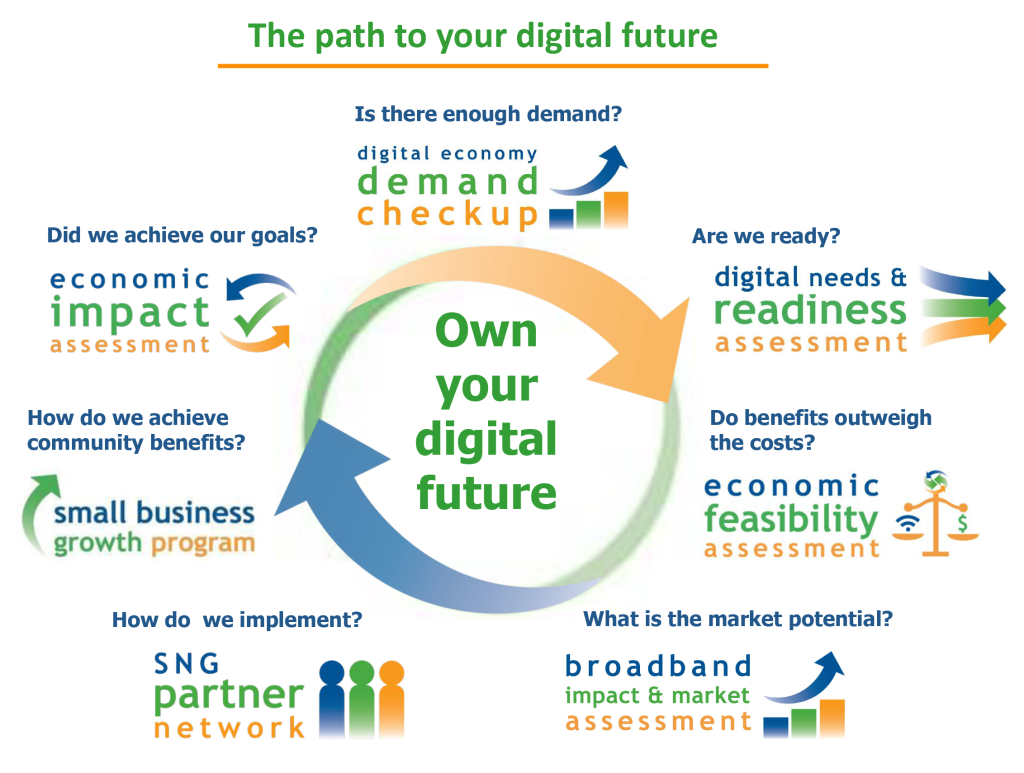Covering the Costs of Broadband and Digital Infrastructure
What can your community do about broadband and how do you invest?
There is a reason that many communities and regions continue to have unserved (no broadband) and underserved (poor quality internet service) areas – there is not enough of a business case for private sector internet service provider investment. They are focusing on opportunities that are more profitable.
SNG shows a new way to pay for broadband by approaching it as digital infrastructure.
The core network can be self-financed through cost-recovery and subscribers opt-in to finance the access network (see how the City of Ammon used Broadband Improvement Districts). All this can be paid for with existing budgets that can be reallocated. The money is hiding in plain sight!
Elected officials and community leaders can now take control of their own broadband future and finally move forward with broadband as essential infrastructure for their businesses and residents – see article: How can municipalities take control of their broadband future?

Investment priorities for your community
All communities and regions are challenged in how to allocate scarce resources among various interests – especially when those interests appear to be competing for funding. Broadband should not be seen as competing for funding nor as an end in itself, but as enabling infrastructure for local economic growth and improved delivery of civic services.
SNG has developed an investment framework for broadband as an enabler of community and economic development goals. It is based on the United Nation’s Sustainable Development Goals (SDGs) adopted by 193 countries in the 70th UN General Assembly in 2015 for governments, businesses, civil society and the general public to work together to build a better future for everyone. SNG has adapted a subset of the SDGs that are applicable to industrialized countries in an increasingly digital economy.
Making the broadband investment decision
When the value of broadband and digital infrastructure is not clear nor quantified, the consequence is under-investment.
Communities and regions investment decisions based on the needs of their residents and businesses. SNG’s research shows that the majority of businesses, organizations, and households do not understand the potential value of broadband and applications enabled by the internet can have. What has been missing and what is needed is a way to personalize the return on investments in digital connectivity to communities, businesses, and residents.
When considering investments in broadband infrastructure community leaders have an opportunity – and increasingly an obligation – to look beyond the typical private sector business case of broadband and digital infrastructure. There are broader community benefits which include:
- Cost reductions for municipal services, as well as vital community institutions, such as schools and libraries.
- Cost savings for residents and businesses that make broadband more affordable, increasing broadband access and use.
- Economic growth opportunities driven by the availability and use of improved broadband services across the community.
In addition to these quantifiable benefits the improved broadband opens up new opportunities for innovative municipal services, including smart city services, for the benefit of citizens. The overall improved vitality of the community can have further positive impacts on property values and local taxes.
What kind of broadband investment?
An increasing number of municipalities have chosen a path to build and operate their own municipal broadband networks or have done so through municipal utility networks. While building and operating a network as a broadband provider is one solution, it is not the only option available to community leaders. Establishing the right broadband infrastructure in the right way, considering all the factors, leads to sustainable, long-term solutions. The right solution and its costs need to be consistent with the benefits that will result from the investment.
SNG has applied our unique and extensive research and experience to assist community leaders in evaluating the costs and benefits beyond the business case to reach the right investment decision.
Developing Policies and Plans That Help Communities
Effective broadband research empowers policies and initiatives that help communities … using empirical data to build buy-in.
Any agency at federal, state, and regional level that wants to assist communities and regions in addressing their digital infrastructure needs should start with empirical data on the current state of broadband availability and use.
While much time and effort has focused on broadband availability maps and network costs, this information is only half the story – at SNG we call this the supply side of broadband. When you look at broadband supply gaps in isolation, the costs to bridge those gaps can be prohibitive and this results in an under-investment in digital infrastructure.
The investment drivers for digital infrastructure are the expected returns from how broadband can be effectively leveraged for social benefits and economic growth. Ultimately it is what people can and will do with broadband that delivers the desired community benefits and economic impacts. At SNG we call this the demand side of broadband. Assessing community returns on broadband investment is essential and a holistic approach to investing in digital infrastructure and programming that may not need to raise taxes, nor take on unsustainable debt. The Ammon case example shows how community benefits outweigh the broadband investment costs.
Looking beyond broadband connectivity and its value to users, having unconstrained digital infrastructure enables communities large and small to make the transformation to smart communities with smart city services that improve community vitality and competitiveness while reducing municipal costs. Ubiquitous, quality broadband connectivity is a key underpinning for essential digital infrastructure.
“Michael Curri and SNG give quantifiable reasons to deploy broadband. Their research provides hard data that is specific to a community, region, or state, not opinions, feelings, assumptions, or conjecture. Finally we have access to facts that enable informed decisions so we can confidently define a path forward and acquire favorable financing.”
Joseph Franell
CEO – Eastern Oregon Telecom
Chair – Oregon Broadband Advisory Council
Informing policies and plans
Much effort has been devoted to addressing broadband availability issues, including establishing regulatory policies, strategic plans, or funding programs. While this is needed, much less attention has been typically given to ensuring that the full potential of broadband is realized by communities and regions. Understanding the current state of broadband use is the fundamental demand driver of broadband. See how the State of Tennessee assessed their current state of broadband availability and use.
Empirical data that benchmarks the needs and uses of broadband directly from citizens and businesses can build buy-in on which gaps and opportunities to focus. Time and money are limited, so an evidence-based approach is fundamental to more effectively targeting investments that address the needs of a community or region and help them achieve desired outcomes. Furthermore, a current state of broadband assessment establishes a benchmark and provides a reference base against which to measure impacts of policies and programs over time – at SNG we call this measuring the community return on investment.
“SNG’s Research and Report helped lay the foundation for the passage of the Broadband Accessibility Act to deregulate, invest, and educate to increase broadband access and adoption in Tennessee.”
Amanda Martin, Director
State of Tennessee Broadband Office
What do you need to know?
Through SNG’s research of best practices on broadband benchmarking around the globe, as well of our years of experience in conducting current state of broadband assessments, we have defined the right metrics to make the right decisions:
- Utilization – How citizens and businesses are currently using or plan to use broadband.
- Drivers – The importance of factors that motivate broadband utilization.
- Barriers – The importance of factors that inhibit or prevent effective broadband utilization.
- Benefits – The importance of broadband for creating positive impacts for users.
- Impacts – The quantification of benefits realized by businesses and households.
- Profile – Information about user characteristics and their Internet connectivity.
Armed with empirical data and an evidence-based approach to investing in digital infrastructure, agencies at a federal, state, and regional level can develop policies and programs and build buy-in around:
- Current state of broadband use by market segments (demographics, industries, etc.)
- Economic impacts already achieved from investing in broadband
- Potential economic benefits to be realized from increasing adoption and utilization
- Gaps and opportunities by sectors and locations
- Future broadband needs
- Need for awareness and adoption programs

Understanding both supply and demand for broadband is not only a more holistic approach, but also uncovers how to fund investments in infrastructure and programming.
Research current state of broadband uses and needs
Get a current state assessment of broadband uses, needs, gaps and opportunities for more effective policies and programs.
Learn how SNG’s eSolutions Benchmarking can deliver empirical data and essential analytics for effective broadband strategies.
Take a holistic approach
Assessing both demand and supply of broadband, provides a holistic approach to understanding community return on investment, broadband uses, needs, gaps and opportunities.
Learn about SNG’s unique Holistic Approach tailored to your broadband strategy to achieve your goals
Evaluate Broadband Benefits
Evaluating broadband’s costs and benefits is the first critical step toward owning your broadband future.
Learn how SNG’s Economic Feasibility Assessment can quickly and affordably get you to the right broadband investment decision.
Assess Broadband Demand
Clearly identifying demand for improved broadband is a critical element in planning your broadband project.
Learn about SNG’s unique Broadband Impact and Market Assessment tailored to your broadband strategy to optimize your success.

